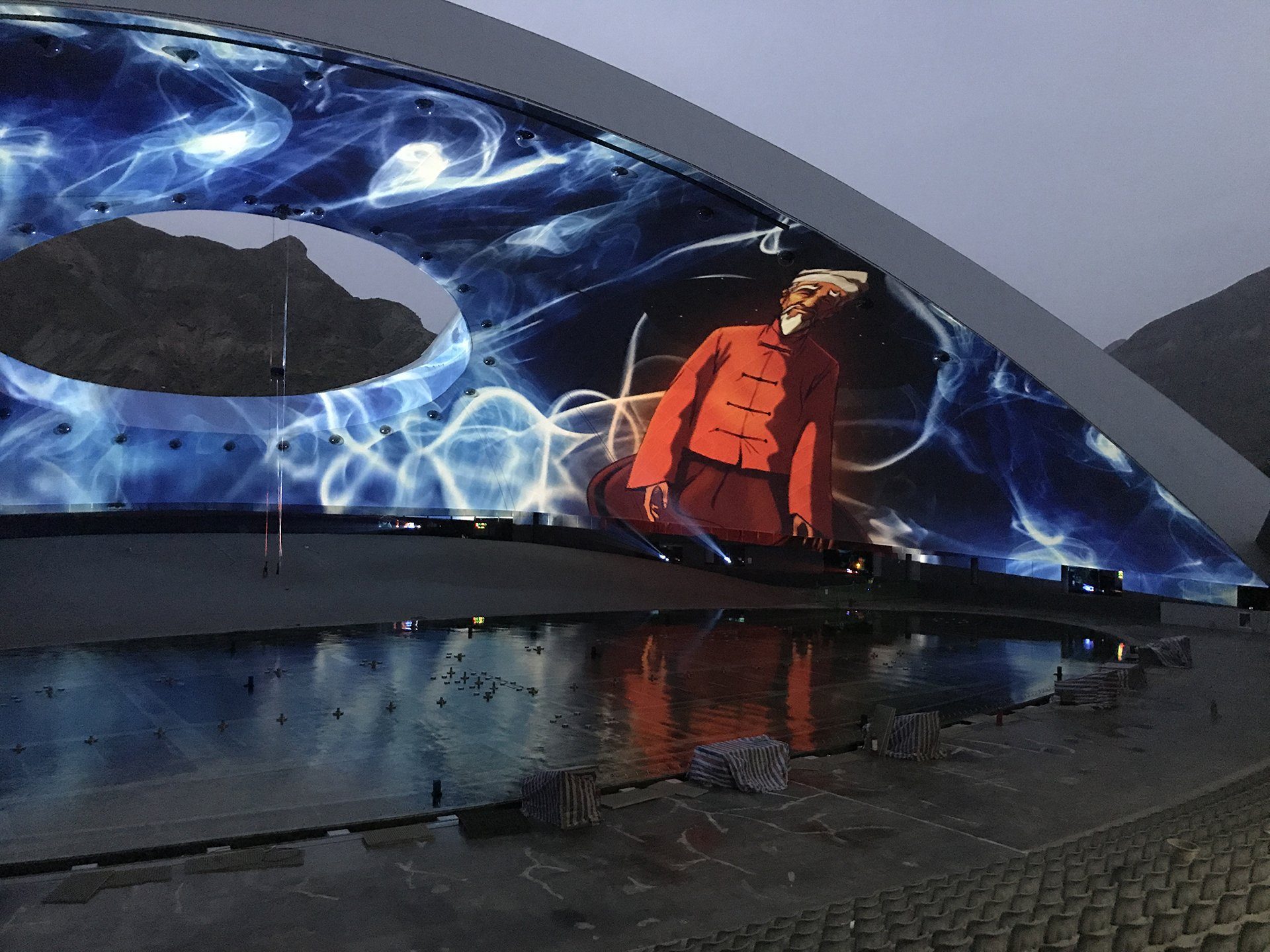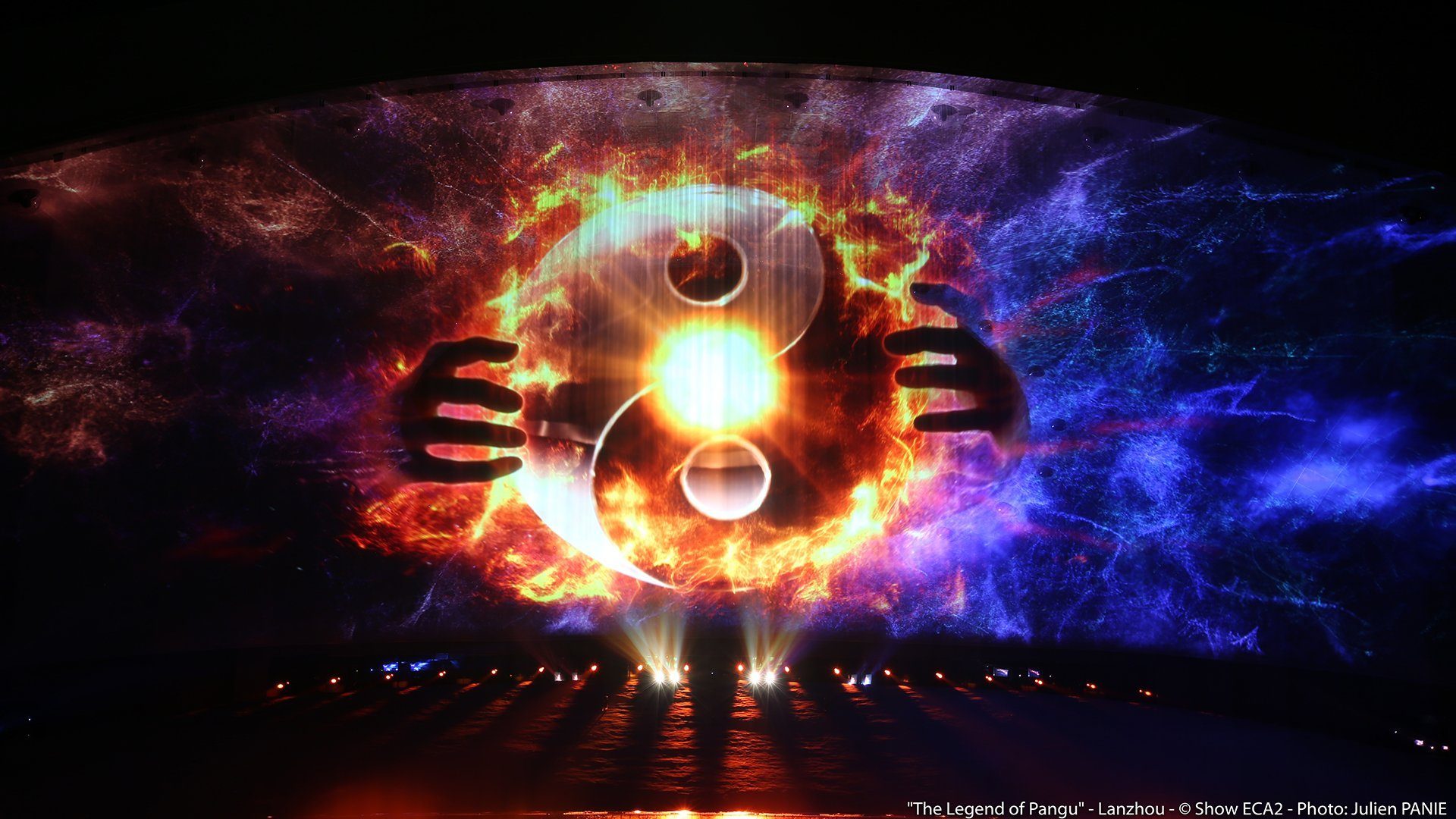Show Design & Production: ECA2
Photo: Julien PANIE
Full credit list available under article
For the Legend of Pangu spectacular, ECA2 selects Modulo Pi’s media servers with new auto-calibration feature
Opened in September 2019, The Legend of Pangu is a spectacular multimedia show created by leading design and production company ECA2. The permanent show is hosted in Lanzhou, China, in a 1.500 seats semi-outdoor immersive theater built for that purpose. The venue relies on a solid AV setup including 30 Christie video-projectors, as well as 8 x Modulo Kinetic media servers with new feature for multi-projector auto-calibration.
To conduct the project in Lanzhou, ECA2 was appointed by Gansu Xirong Cultural Tourism Development Co., Ltd., a public agency dedicated to cultural and tourism promotion throughout China.
The project called for the creation of a stunning immersive multimedia show integrating ancient Chinese tales with modern architecture and culture, with support of cutting-edge technology. ECA2 was entrusted with the whole project including theater design, show creation and production, as well as AV integration.
In terms of venue design, ECA2 conceived a theater of 110 x 100 x 38 meters with 1.500 seats. Built especially for the show, the theater offers a remarkable architecture with a dome and an open sky in the center. The audience area is located under one half of the dome, and faces the other half used for the stage. In the stage area, the dome roof includes a hole to support the show scenography and use of water, lighting, and laser effects.
Based on this semi-indoor semi-outdoor theater, ECA2 designed and produced The Legend of Pangu, a 26-minute show about the creation of the universe played at night-time.
Clément Rabréaud, Technical Director of the show, explains: “In The Legend of Pangu, video-projection and audio serve as the base for the narration. Then, all effects, lasers, lights, water, flames, and pyrotechnics are added to turn the narration into an immersive and spectacular multimedia show.”
The AV set-up includes 30 x Christie video-projectors and 8 x Modulo Kinetic media servers by Modulo Pi (2 x Modulo Kinetic Designer workstations and 6 x V-Node servers).
“For such permanent shows, the AV equipment must be at the cutting edge of technology, extremely reliable, but also easy to use and maintain on a daily basis” says Clément Rabréaud. “The objective is that the local team be the most independent possible in the management of the system, which implies relying on very steady equipment. Reliability is part of the reasons why ECA2 chose the Modulo Kinetic solution.”
For The Legend of Pangu, Modulo Kinetic was used for show simulation and VR, programming, effects, and media playback. “Apart from all regular functionalities, Modulo Kinetic offers in-depth 3D capabilities and a flexibility that is rare in the offer of media server solutions” comments Rabréaud.
Video-projection being a major part of the show, ECA2 installed 2 x water screens: The Magic Screen© is a mobile projection surface of 400 sqm, and the Cascade Screen© is a largest double curved water curtain screen ever built, adding another 960 sqm of projection.
Both water screens allow for overlapping projections by playing with the water transparency. They rely on 8 x Christie Crimson HD 25K, and 2 x Christie DS+ 14K-M.
For the projection on the dome, 20 x Christie Boxer 2K30 were required resulting in 2.800 sqm covered.
Achieving such a video mapping on a double curved asymmetric dome represented the biggest challenge for teams of ECA2. To allow seamless media projection throughout the show with no beam of lights altered by the many water effects, video-projectors had to be installed as 10 x dual stacks throughout the base of the dome. The position of the video-projectors resulted in extremely deformed and glancing projection, turning their calibration into a very difficult task.
“The system calibration on the Lanzhou asymmetric dome was a major challenge: 20 video-projectors, 20 different video feeds, an asymmetric projection area with a double curve, a position of video-projectors resulting in glancing beams. All of that promised a finicky and extremely time-consuming calibration despite the highly skilled video technicians working on the project” says Rabréaud. “It also meant that any new calibration after a projector is moved would be almost impossible for the operators running the show on-site, as they are not trained for such complex and tricky maintenance operations.”
To face such a challenge, ECA2 could rely on Modulo Kinetic’s auto-calibration feature which was under development during the Lanzhou project. “A few weeks before the install and the show programming, auto-calibration became a vital feature for this show. The function was not ready yet, but Modulo Pi agreed to play the game and to develop the auto-calibration functionality while we were doing our install. Régis Dumaine, in charge of the installation of the video system, and Lawrence Ryan, ECA2 technical manager, worked in close collaboration with Modulo Pi by testing the developments made by the R&D team in France directly in Lanzhou” explains Clément Rabréaud.
Modulo Kinetic’s auto-calibration was operational shortly before the end of the show programming, and allowed to automatically handle the video-projectors soft edge blending and geometry in a short time frame : “On complex surfaces such as the asymmetric dome, the calibration by a skillful video operator would have taken at least one week. Using the auto-calibration feature, it took less than one hour and provided a better result in terms of luminosity compared to any manual calibration” notes Rabréaud.
Developed through 30 months with a team of 150 professionals involved, the Lanzhou theater and The Legend of Pangu show opened in September 2019.
Used in a beta version during the Lanzhou project, Modulo Pi’s auto-calibration feature has been launched in September 2020.
Credits:
Producer: Jean-Christophe CANIZARES
Creative Design, Direction & Storytelling: Olivier FERRACCI
Director of Operatons: Julie CUGURNO
Technical Director: Clément RABRÉAUD
Chief Architect & Stage Design: Chengcheng CHI
Head Of Business Development: Emmanuelle CHAROTTE
Video Technical studies: François ROCCHETTI
Video system setup and calibration: Régis DUMAINE
Video programming: Vlad TOLIC
Technical Manager: Lawrence RYAN


















